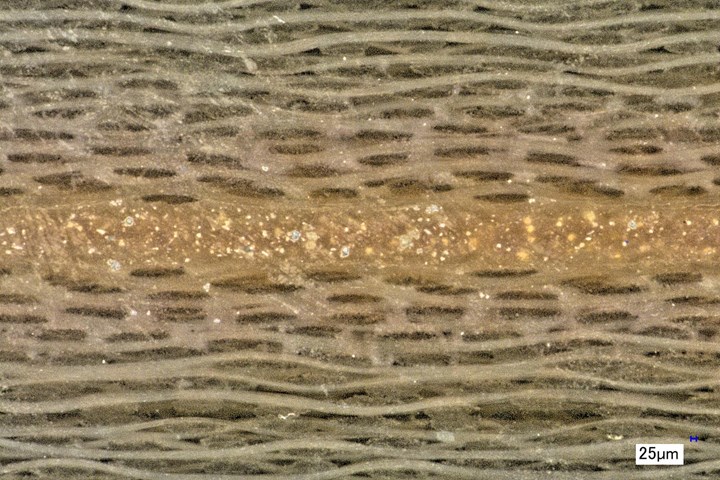Solvay expands range of FusePly covalent bonding for composite structures
FusePly 250 technology, designed for 250°F to 350°F composite bonding, offers optimized bond reliability and high part performance.
Share
Microscopic view of FusePly resin (at the interface with prepreg and adhesive) ingressing into the composite panel during co-cure (as indicated by discolored composite layers) and delivering a chemically bonded interface between FusePly and adhesive. Photo Credit: Solvay
Solvay (Alpharetta, Ga., U.S.) has expanded its range of FusePly chemical bonding technology with a second product, FusePly 250, designed to bond composite structures at 250°F and higher. The new product complements the previous FusePly 100 grade, introduced in 2018 which has now been renamed FusePly 350 to reflect its compatibility with 350°F cure film adhesives. Both grades offer step-change bonding performance and durability and can easily be integrated into existing manufacturing processes as an upgrade for traditional surface preparation methods.
Solvay reports that FusePly is a breakthrough composite bonding technology resulting in covalent bonds between adhesives and composite structures. While it handles and processes like a conventional peel ply product, it creates a reliable chemically functionalized composite surface which eliminates time- and labor-intensive surface preparation steps and assembly processes.
“The reliability and robustness of bonded structures are a top priority for users of composites in safety-critical applications in aerospace and other demanding markets” says Stephen Heinz, VP research and innovation for Solvay’s global Composite Materials business unit. “We developed FusePly, a fundamentally new bonding approach, to meet the needs of leading aircraft OEMs and enable them to take full advantage of composites for lighter, stronger structures.”
Related Content
-
Welding is not bonding
Discussion of the issues in our understanding of thermoplastic composite welded structures and certification of the latest materials and welding technologies for future airframes.
-
Large-format 3D printing enables toolless, rapid production for AUVs
Dive Technologies started by 3D printing prototypes of its composite autonomous underwater vehicles, but AM became the solution for customizable, toolless production.
-
Novel dry tape for liquid molded composites
MTorres seeks to enable next-gen aircraft and open new markets for composites with low-cost, high-permeability tapes and versatile, high-speed production lines.

